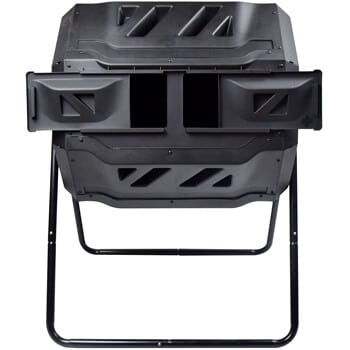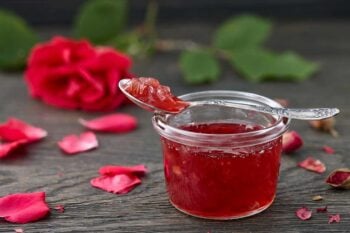Composting is a sacred act. A person who composts thoughtfully is a shepherd over the transformation from death into life. Without the holy cycle of decay and rebirth that the composter harnesses for her garden, life on this planet could not exist.
Composting is far more than just free fertilizer for the garden. It’s a vital and necessary sustainability strategy for reducing waste, closing the nutrient cycle, and preventing air pollution that causes climate change.
This article contains affiliate links. As an Amazon Associate I earn from qualifying purchases.
Composting can remove 20-50% from your household waste stream, reducing the burden on landfills while replenishing your lawn, trees, houseplants, or garden for free. (And if you pay for trash pick-up, composting can save you money there, too.)
When organic matter like food waste goes to the landfill, it ends up decomposing anaerobically—or without oxygen. This process creates methane, a greenhouse gas 20-35 times more potent than carbon dioxide at warming our planet. Landfills are the United States’ third largest source of methane emissions, according to the EPA.
If we composted food and other organic waste instead of throwing it away, we’d need fewer landfills, and they wouldn’t emit methane. Food does not belong in landfills.
Compost = Life
For your soil, there is no more powerful ingredient than compost. Whether you till it into your garden beds or use it as mulch around shrubs and trees, it is considered essential to organic and sustainable food production. Once it’s in the soil, finished compost—or humus—increases fertility, adds both micro- and macronutrients, buffers pH, prevents diseases, breaks down toxins, and improves soil structure.
But even if you don’t have a garden, composting is still a vitally important practice. We humans take far more carbon, minerals and organic matter from the soil than we put back. But without organic matter, soil becomes dead, inert mineral dust that won’t grow anything but weeds.
Returning as much of our organic waste as we can to the soil will begin to rebalance the nutrient cycle we depend on for our very survival.
Composting Basics
The basics of composting are simple. Pretty much anything that once lived or was made from a living thing can be composted. As long as an item contains all natural components, it will decay, decompose and break down, returning it’s nutrients to the soil.
A compost pile can be as easy as starting a heap of veggie scraps, dead leaves, and grass clippings in the far corner of your yard, but most people like to contain their compost in a neat-looking compost bin.

There are many different kinds of compost bins to fit every living situation: simple pallet bins, tumblers that make turning the compost easy, towers for urban yards and small spaces, and even worm composters that will make fast, odorless work of all your table scraps in the space under your kitchen sink. Select the bin style that works for you, and if it is an outdoor model, install it near the garden, away from your house.
Once you have reached a critical mass of scraps in your bin (usually about a cubic yard of material or a 3’x3’x3′ pile), it will begin to noticeably break down. After everything has decomposed and transformed into dark, rich-smelling, crumbly humus (see picture above), you can sprinkle it around your trees, lawn, garden or houseplants to help them grow.
Considered “black gold” by most gardeners, even if you don’t garden yourself, you could easily give your compost away to your neighborhood green thumb! She’d be so grateful. Avid gardeners never seem to have enough compost.
Speeding Up Your Compost
Compost happens.
If you leave an apple on a table, it will eventually decay and break down into a little pile of dirt. There’s really nothing you need to do to get compost to happen except make a pile of things to rot outside. But if you want to get your compost pile to break down quickly and evenly so you can use it regularly in your garden, here are a few things to keep in mind:
The Right Balance
An efficient compost pile is a careful balance of dry or brown things that contain carbon (like leaves, straw, or paper) and wet or green things that contain nitrogen (like food scraps or rabbit droppings).
So, for example, if you add a lot of shredded leaves or cardboard to the pile, you will need to balance and mix it with a nice heap of fresh grass clippings or horse manure, and probably some water from the hose so things don’t get too dry.
I like to keep a small stockpile of horse manure (green) and straw (brown) or dry grass clippings on hand nearby as fodder to keep my pile in balance so it decomposes quickly.
Small Surface Area
The smaller you can shred or chop your compostable items before you put them into the pile, the faster and more evenly they will decompose. It’s really worth the extra effort to chop and shred if you plan to use your compost for vegetable gardening.
Put slow-composting things like tree branches, nut shells, hair, latex, and old cotton or hemp rope into a separate pile at the back of your lot, while keeping your faster compost pile closer to the garden.
Air and Water
Turn your compost pile weekly to mix and aerate it, which will help everything to decompose much faster. You can do this with a pitchfork, but a compost tumbler bin can make this incredibly easy.
Make sure your compost pile stays moist, like a damp sponge. Hose it down if it’s too dry; turn it more often if it’s too wet. The balanced combination of air and moisture in the pile ensures that the microorganisms breaking down your compost have everything they need to thrive and reproduce themselves.
Know Your Limits
While you technically can compost any food, whether animal-based or plant-based, some things are better left out of the average home compost pile. For example, if you add fish, meat or a lot of fat to your compost pile, as they decompose, they will create a strong smell that will annoy your neighbors and bring every critter for miles to your yard! When in doubt, leave it out.
Related: 10 Things You Should Not Put In Your Compost Pile
Also consider how much space you have to compost. For example, if you live in an apartment, you will be limited to vermicomposting just your kitchen scraps. But that doesn’t mean you can’t compost other things. Does your city have a municipal composting program or a community garden that composts? Do you have a friend who gardens, who might like to have your coffee grounds or birdcage papers?
Everything we can do to keep compostable materials out of the landfill will help prevent pollution and restore our depleted soils.
100 Things You Can Compost
The following list is meant to get you thinking about your compost possibilities. Imagine how much trash we could prevent from going into the landfills if each of us just decided to compost a few more things!
(G) refers to items that are mostly “green” or nitrogenous, or that decompose very quickly; (B) refers to items that are mostly “brown” or carbonaceous, or that take much longer to decompose.
From the Kitchen
- Fruit and vegetable scraps (G)
- Egg shells (crushed) (B)
- Coffee grounds (G)
- Coffee filters (B)
- Tea bags (Make sure they are made of natural materials like hemp or cotton, and not rayon or other synthetic fabrics. If in doubt, just open it and compost the tea leaves alone.) (B)
- Loose leaf tea (G)
- Spoiled soy/rice/almond/oat/coconut milk (G)
- Used paper napkins and paper towels (B)
- Unwaxed cardboard pizza boxes (ripped or cut into small pieces) (B)
- Paper bags (shredded) (B)
- The crumbs you sweep off of the counters and floors (B)
- Cooked pasta (G)
- Cooked rice (G)
- Stale bread, pitas, or tortillas (B)
- Stale tortilla chips or potato chips (B)
- Spoiled pasta sauce or tomato paste (G)
- Crumbs from the bottom of snack food packaging (B)
- Paper towel rolls (shredded) (B)
- Stale crackers (B)
- Stale cereal (B)
- Cardboard boxes from cereal, pasta, etc. (Remove any plastic windows and shred) (B)
- Used paper plates (as long as they don’t have a waxy coating) (B)
- Nut shells (except for walnut shells, which are toxic to plants) (B)
- Spoiled tofu and tempeh (G)
- Seaweed, kelp or nori (G)
- Unpopped, burnt popcorn kernels (B)
- Old herbs and spices (G)
- Stale pretzels (B)
- Stale candy (crushed or chopped) (G)
- Stale protein or “energy” bars (G)
- Pizza crusts (B)
- Old oatmeal (B)
- Peanut shells (B)
- Cardboard egg cartons (cut them up) (B)
- Stale pumpkin, sunflower or sesame seeds (chopped up so they can’t sprout) (G)
- Avocado pits (chopped up so they don’t sprout) (G)
- Wine corks (chop up so they decompose faster) (B)
- Moldy cheese (in moderation) (G)
- Melted ice cream (in moderation) (G)
- Old jelly, jam, or preserves (G)
- Stale beer and wine (G)
- Toothpicks (B)
- Bamboo skewers (break them into pieces) (B)
- Paper cupcake or muffin cups (B)
From the Bathroom
- Used facial tissues (B)
- Hair from your hairbrush (B)
- Trimmings from an electric razor (B)
- Toilet paper rolls (shredded) (B)
- Old loofahs (cut up, natural only) (B)
- Nail clippings (B)
- 100% latex or lambskin condoms (B)
- 100% cotton cotton balls (B)
- Cotton swabs made from 100% cotton and cardboard (not plastic) sticks (B)
- 100% cotton tampons and sanitary pads (including used) (B)
- Cardboard tampon applicators (B)
- Menstrual blood (G)
- Urine (G)
From the Laundry Room
- Dryer lint (from 100% natural fabrics only!) (B)
- Old cotton clothing and jeans (ripped or cut into small pieces) (B)
- Cotton fabric scraps (shredded) (B)
- Old wool clothing (ripped or cut into small pieces) (B)
- Old cotton towels and sheets (shredded) (B)
From the Office
- Bills and other plain paper documents (shredded) (B)
- Envelopes (shredded, minus the plastic window) (B)
- Pencil shavings (B)
- Sticky notes (shredded) (B)
- Old business cards (shredded, as long as they’re not glossy or embossed) (B)
Around the House
- “Dust bunnies” from wood and tile floors (B)
- Contents of your dustpan (pick out any inorganic stuff, like pennies and Legos) (B)
- Crumbs from under your couch cushions (again, pick out any inorganic stuff) (B)
- Newspapers (shredded or torn into smaller pieces) (B)
- Junk mail (shredded, remove coated paper and plastic windows) (B)
- Subscription cards from magazines (shredded) (B)
- Burlap sacks (cut or torn into small pieces) (B)
- Old rope and twine (chopped, natural, unwaxed only) (B)
- Leaves trimmed from houseplants (G)
- Dead houseplants and their soil (B)
- Flowers from floral arrangements (G)
- Natural potpourri (B)
- Used matches (B)
- Ashes from untreated wood burned in the fireplace, grill, or outdoor fire pits (in very small amounts) (B)
- Grass clippings (G)
- Dead autumn leaves (B)
- Sawdust (from plain wood that has NOT been pressure-treated, stained or painted) (B)
Party and Holiday Supplies
- Wrapping paper rolls (cut into small pieces) (B)
- Paper table cloths (shredded or torn into smaller pieces) (B)
- Crepe paper streamers (shredded) (B)
- Latex balloons (Make sure they are latex!) (B)
- Jack O’lanterns (smashed) (G)
- Those hay bales you used as part of your outdoor fall decor (broken apart) (B)
- Natural holiday wreaths (chop up with pruners first) (B)
- Christmas trees (chop up with pruners first, or use a wood chipper, if you have one…) (B)
- Evergreen garlands (chop up with pruners first) (B)
Pet-Related
- Fur from the dog or cat brush (B)
- Droppings and bedding from your herbivorous pet rabbit, gerbil, hamster, etc. (Do NOT use dog or cat poop.) (G)
- Newspaper/droppings from the bottom of the bird or snake cage (G)
- Feathers (B)
- Horse, cow or goat manure (G)
- Alfalfa hay or pellets (usually fed to rabbits, gerbils, etc.) (B)
- Dry dog or cat food, fish pellets (B)
Just imagine if all of us kept so many things out of the landfills and returned their nutrients to the earth?
For a truly sustainable future that our great-grandchildren can thrive in, closing the nutrient cycle by composting is essential, or we will deplete our precious soils into dust. Good thing it is such an easy and frugal thing to do!









